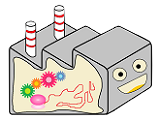Team:Gifu/Modeling
From 2014.igem.org




Modeling
Summary
We examined the efficiency of circularization of mRNA in E. coli. The mRNA synthesized by transcription of induced plasmid may be considered that there are mainly 3 shape patterns in the process of circularization (fig.1).



In this experiment, we carried out reverse transcription of RNA of Escherichia coli, and calculated the abundance ratio of each shape pattern by detecting specific sequences by using MPN-PCR (Most Probable Number-PCR).
By examining the abundance ratio of sequence A, B or C, D , and B / A shows the probability that the reaction doesn’t start (step Ⅰ). Also, we can calculate the probability that RNA will cyclize (step Ⅱ,Ⅲ) by C and D. By examining these, we investigated the rate-limiting step in the process of cyclization or probability to cyclization of the RNA.
Experiment
We extracted total RNA from E. coli and then carried out the reverse transcription. This time we used the two types of primer; oligo dt primer and random primer. And we carried out reverse transcription with them. We serially diluted obtained cDNA, and calculated abundance rate by using MPN-PCR.
Case 1: Determination of the sequence A and B
We carried out reverse transcription with the oligo dt primer which complementary to the poly A sequence at the 3 'end of the mRNA (fig.2).

Oligo dt primer anneals specifically to the 3 'end of the mRNA, so the ratio of reverse transcription of A and B are the same. Thus, B/A calculated by the MPN-PCR shows the abundance ratio of step Ⅰ, that is, the probability that no reaction started.
Case 2: Determination of the sequence C and D
Since there’s no poly A sequence on the mRNA after starting cyclization, it’s impossible to use the oligo dt primer. Therefore, we use the random primer. However, some problems arise when we determine them with random primer.
Problems
Reverse transcription is carried out in the following steps.
- Primer is added to RNA.
- The cDNA is synthesized by reverse transcriptase.
- Inactivation of reverse transcriptase.
It means, if primer annealed to C or D, this sequence doesn’t exists in cDNA. And if primer did not anneal.
We calculated the ratio made C or D in cDNA each step, when we carried out reverse transcription with random primer.
- The ratio of random primer annealing depend on only base pare of RNA.
- When mRNA was transcribed from DNA, transcription finished at the same sequence.
- There was not shape pattern of RNA without figure 1.
On the step Ⅰ, when random primer annealed the sequence where circularized and 3’ end, the ratio that D is reverse transcribed is the following.
Step Ⅰ

Support from other team
Because our theme “Circular mRNA” is qualitative experiment, we had a hard time with Modeling. That’s why A member of UT-Tokyo thought about the Modeling about our theme.
- Growth curve of E. coli and overexpression of protein by circular mRNA
→How much does the synthesis of long-chain protein influence growth of E. coli?
By comparing our result with control (empty vector or non-plasmid), we decide parameter. We also learnt it from UT-Tokyo that past studies will be good references for these population dynamics.
https://2013.igem.org/Team:British_Columbia/Modeling - Does the strength of circular mRNA depend on the length of exon?
If we can make a parameter which shows how long the insert is the most stable when we had Circular mRNA, this will be helpful for the correction of the model.
We greatly appreciate UT-Tokyo taught us Modeling despite their busy.
 "
"